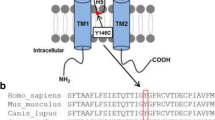Abstract
The KCNQ1 channel is abundantly expressed in the gastric parietal cells. Although the functional coupling of KCNQ1 with the H+/K+-ATPase has already been confirmed on the basis of pharmacological kinetics, the effect of a KCNQ1 loss-of-function mutation on gastric acidification remains unclear. In this study, parietal cells and gastric glands from both C57BL/6 J mice (normal control) and J343 mice (mice with a KCNQ1 loss-of-function mutation) were isolated to study the effects of KCNQ1 on gastric acidification. We found that the mutation limited intracellular acidification of parietal cells and H+ secretion of the stomach in response to histamine. Thus, a KCNQ1 loss-of-function mutation may impair gastric acid secretion.



Similar content being viewed by others
References
Robbins J (2001) KCNQ potassium channels: physiology, pathophysiology, and pharmacology. Pharmacol Ther 90:1–19. doi:10.1016/S0163-7258(01)00116-4
Sanguinetti MC, Curran ME, Zou A, Shen J, Spector PS, Atkinson DL, Keating MT (1996) Coassembly of K(V)LQT1 and minK (IsK) proteins to form cardiac I(Ks) potassium channel. Nature 384:80–83. doi:10.1038/384080a0
Lee MP, Ravenel JD, Hu RJ, Lusting LR, Tomaselli G, Berger RD, Brandenburg SA, Litzi TJ, Bunton TE, Limb C, Francis H, Gorelokow M, Gu H, Washington K, Argain P, Goldenring JR, Coffey RJ, Feinberg AP (2000) Targeted disruption of the Kvlqt1 gene causes deafness and gastric hyperplasia in mice. J Clin Invest 106:1447–1455. doi:10.1172/JCI10897
Dedek K, Waldegger S (2001) Colocalization of KCNQ1/KCNE channel subunits in the mouse gastrointestinal tract. Pflugers Arch 442:896–902. doi:10.1007/s004240100609
Lambrecht NW, Yakubov I, Scott D, Sachs G (2005) Identification of the K efflux channel coupled to the gastric H-K-ATPase during acid secretion. Physiol Genomics 21:81–91. doi:10.1152/physiolgenomics.00212.2004
Waldegger S (2003) Heartburn: cardiac potassium channels involved in parietal cell acid secretion. Pflugers Arch 446:143–147
Grahammer F, Herling AW, Lang HJ, Schmitt-Gräff A, Wittekindt OH, Nitschke R, Bleich M, Barhanin J, Warth R (2001) The cardiac K+ channel KCNQ1 is essential for gastric acid secretion. Gastroenterology 120:1363–1371. doi:10.1053/gast.2001.24053
Heitzmann D, Warth R (2008) Physiology and pathophysiology of potassium channels in gastrointestinal epithelia. Physiol Rev 88:1119–1182. doi:10.1152/physrev.00020.2007
Heitzmann D, Warth R (2007) No potassium, no acid: K+ channels and gastric acid secretion. Physiology (Bethesda) 22:335–341. doi:10.1152/physiol.00016.2007
Casimiro MC, Knollmann BC, Yamoah EN, Nie L, Vary JC Jr, Sirenko SG, Greene AE, Grinberg A, Huang SP, Ebert SN, Pfeifer K (2004) Targeted point mutagenesis of mouse Kcnq1: phenotypic analysis of mice with point mutations that cause Romano-Ward syndrome in humans. Genomics 84:555–564. doi:10.1016/j.ygeno.2004.06.007
Chen L, Sun XD, Zhao J, Yang AG, Huang WQ (2005) Distribution, cloning and sequencing of GnRH, its receptor, and effects of gastric acid secretion of GnRH analogue in gastric parietal cells of rats. Life Sci 76:1351–1365. doi:10.1016/j.lfs.2004.10.005
Huber SM, Braun GS, Segerer S, Veh RW, Horster MF (2000) Metanephrogenic mesenchyme-to-epithelium transition induces profound expression changes of ion channels. Am J Physiol Renal Physiol 279:F65–F76
Kirchhoff P, Wagner CA, Gaetzschmann F, Radebold K, Geibel JP (2003) Demonstration of a functional apical sodium hydrogen exchanger in isolated rat gastric glands. Am J Physiol Gastrointest Liver Physiol 285:G1242–G1248
Vallon V, Grahammer F, Volkl H, Sandu CD, Richter K, Rexhepaj R, Gerlach U, Rong Q, Pfeifer K, Lang F (2005) KCNQ1-dependent transport in renal and gastrointestinal epithelia. Proc Natl Acad Sci USA 102:17864–17869. doi:10.1073/pnas.0505860102
Heitzmann D, Grahammer F, von Hahn T, Schmitt-Gräff A, Romeo E, Nitschke R, Gerlach U, Lang HJ, Verrey F, Barhanin J, Warth R (2004) Heteromeric KCNE2/KCNQ1 potassium channels in the luminal membrane of gastric parietal cells. J Physiol 561:547–557. doi:10.1113/jphysiol.2004.075168
Schroeder BC, Waldegger S, Fehr S, Bleich M, Warth R, Greger R, Jentsch TJ (2000) A constitutively open potassium channel formed by KCNQ1 and KCNE3. Nature 403:196–199. doi:10.1038/35003200
Warth R, Garcia Alzamora M, Kim JK, Zdebik A, Nitschke R, Bleich M, Gerlach U, Barhanin J, Kim SJ (2002) The role of KCNQ1/KCNE1 K(+) channels in intestine and pancreas: lessons from the KCNE1 knockout mouse. Pflugers Arch 443:822–828. doi:10.1007/s00424-001-0751-3
Tinel N, Diochot S, Borsotto M, Lazdunski M, Barhanin J (2000) KCNE2 confers background current characteristics to the cardiac KCNQ1 potassium channel. EMBO J 19:6326–6330. doi:10.1093/emboj/19.23.6326
Spicer Z, Miller ML, Andringa A, Riddle TM, Duffy JJ, Doetschman T, Shull GE (2000) Stomachs of mice lacking the gastric H, K-ATPase alpha-subunit have achlorhydria, abnormal parietal cells, and ciliated metaplasia. J Biol Chem 275:21555–21565. doi:10.1074/jbc.M001558200
Acknowledgments
This work was supported by the National Science Fund for Distinguished Young Scholars (30425016), the National Science Fund of China (30330290, 30528011 and 30470961), the “973” Program Fund of China (2007CB512100), the “863” Program Fund of China (2007AA02Z438), the Program Fund for Outstanding Medical Academic Leader of Shanghai, China, the Program Fund for Shanghai Subject Chief Scientist, China, the Yangtze Scholars Program Fund by the Ministry of Education, China, and the Program Fund for Innovative Research Team by the Ministry of Education, China (all to Yi-Han Chen).
Author information
Authors and Affiliations
Corresponding author
Additional information
The authors Q. Pan, J. Ma, Q. Zhou, J. Li, and Y. Tang contributed equally to this work.
Rights and permissions
About this article
Cite this article
Pan, Q., Ma, J., Zhou, Q. et al. KCNQ1 loss-of-function mutation impairs gastric acid secretion in mice. Mol Biol Rep 37, 1329–1333 (2010). https://doi.org/10.1007/s11033-009-9511-9
Received:
Accepted:
Published:
Issue Date:
DOI: https://doi.org/10.1007/s11033-009-9511-9




